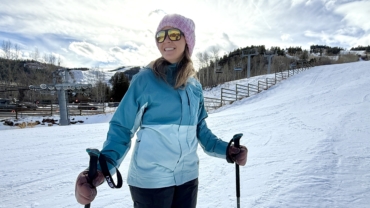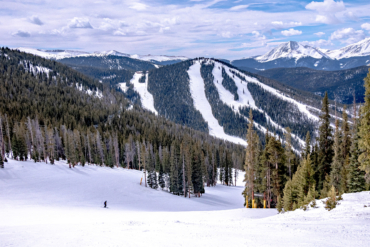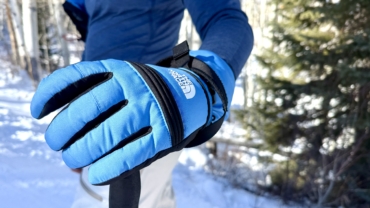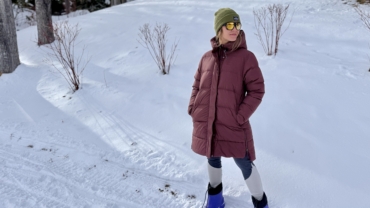It was February, and Bergen Tjossem was about 6 miles into a trail run overlooking Mountain of The Holy Cross when his headphones blasted a winter emergency alert. Within minutes, a powerful storm overtook the trail. He turned around as the wind blasted and fresh snow drifts covered what minutes before had been a packed trail. Without a clear trail, he started post-holing; it took over an hour to get back to the trailhead. By the time he did, his clothing was soaked.
His feet, on the other hand, were miraculously dry. And that wasn’t the first time the SCARPA Ribelle Run Kalibra G winter trail shoes impressed Bergen.
A couple of mountain ranges to the east, GearJunkie editor Mary Murphy was also putting some miles down in the women’s Kalibra G on local trails in Denver, Evergreen, and beyond. Safe to say, these shoes in testing ran, trekked, and tackled snowy winter trails across the state.
In short: The SCARPA Ribelle Run Kalibra G ($240) is an aggressive winter trail shoe designed for runners that refuse to give up trail running during the winter months. The relatively stiff shoes sport a weather-resistant gaiter and a unique BOA Fit System system to keep your feet secure and protected. The gaiter element and zipper design are impressive, even compared to the select few on market with similar BOA dials and gaiter designs.
GearJunkie’s Mary Murphy and Bergen Tjossem tested the women’s and men’s versions of this shoe, respectively. And after many miles and too many post-holes to count, they both came away with positive impressions of the shoes’ performance, comfort, and design. If you are heading out for a more technical winter trail run, hike, or approach in the snow, the SCARPA Ribelle Run Kalibra G is a fantastic choice for footwear.
- Materials: PRESA+ Speed Force sticky rubber (outsole, TPU rand, Polartec Windbloc (upper), Ortholite insoles
- Laces: BOA dial, textile and Dyneema
- Last: ARSF (same as the Ribelle Run model)
- Drop: 4mm
- Sizes: 36-48 EU
- Weight: 11.7 oz. (size 39)
Pros
- Wind- and water-resistant
- Comfortable stretchy upper
- Great traction
- Versatile in all snow conditions
Cons
- Can be fidgety to adjust zipper
- Not crampon-compatible
- Comfortable, but less support than we'd like for longer distances
SCARPA Ribelle Run Kalibra G Review

Design and Build of the SCARPA Ribelle Run Kalibra G
“Juggernaut” (SCARPA’s term) is an appropriate word to describe the Ribelle Run Kalibra G. It’s a burly shoe that’s hungry for challenging terrain. SCARPA’s designers were clearly inspired by mountaineering footwear like their Ribelle Tech 2.0 and Phantom series.
For starters, the tread pattern on the shoe is serious about grip — 4mm deep multidirectional lugs inspire confidence in slippery conditions. Whether that’s a snow-packed trail, deep snow trail, icy sidewalks, rock, dirt, or a combo thereof. And the rubber blend is tuned well for winter conditions.

The 4mm drop midsole is moderately stiff, which also makes a lot of sense for winter running conditions. They edge well on slippery trails and the stiffness drives the lugs for better grip. It also adds significant versatility; the shoe is great for rock scrambling and for use while carrying a heavy pack. A mountaineering-boot-inspired rand adds noticeable protection to both your toes and the shoe itself.
Moving upward, both the men’s and women’s versions tighten using a BOA Fit System. BOA dials are often susceptible to snapping, so both of our testers instinctively approach them with caution. But Mary and Bergen both liked this one. It’s low profile and out of the way.
How else is it unique? SCARPA replaced the typical steel cable laces with a much friendlier TX4 textile lace, braided with Dyneema for strength. They’re threaded around the shoe like normal laces, but also take a lap around the back of the heel.
That makes a big difference. Heel lift, which often plagues other BOA footwear, is a non-issue for the SCARPA Ribelle Run.

The integrated gaiters are perhaps the most noticeable feature of the Kalibra and it’s what sets it apart from non-winter running shoes. Rising about 3 inches from the top of the heel cuff, the gaiter goes on with a diagonal zipper and an elastic strap at the top.
The diagonal zipper here is offset, and not resting directly on the bones on the top of your feet. The gaiter material is Polartec Windbloc, which promises a balance of water resistance and breathability. Both testers found that to be the case out on the trail.
Bergen runs hot, but reported that his feet never overheated or got clammy, nor did they get soaked by the snow — which was a notable victory for this shoe.

However, Bergen did add that he wasn’t crazy about the integration between the BOA knob and the gaiter. There’s a nickel-sized hole in the gaiter that the knob sticks out of — a gap in an otherwise sealed membrane. But, he said, after many post-holes, when he checked the inside of his gaiters there was no intruding snow.
Mary didn’t experience any wet feet during her testing of the SCARPA Kalibra G, either. So, while the holes under the BOA knobs look like exposed openings in the gaiters, they seem to seal up just fine during use.
On the Trail, in the Snow

There’s a very specific use that the Kalibra is perfect for — spring ski touring and mountaineering. By about mid-April in Colorado, most backcountry ski lines require a dirt trail approach long enough to warrant attaching skis and boots to your backpack.
Approach footwear needs to be lightweight and compact (you’ll be stuffing shoes into your pack once you hit consistent snow). They also need to be sturdy since spring skiing packs are heavy, and waterproof because there’s 100% certainty that you will post-hole at some point. The Kalibra G perfectly meets those criteria, Bergen said. Whether that was intentional or not, it’s a great use for these shoes beyond running.
They are also perfect for using on approach trails up to ice climbs/winter ascents for all same reasons, Mary added. They are light, waterproof, protect you from cold and wind, are easy to stash in your pack, and have great traction.
Both Mary and Bergen tested these shoes all over in the Colorado snow, both on maintained trails and off-trail. Wearing these comfortable, secure shoes before they needed to strap on skis or crampons was huge.
The SCARPA Kalibra G shoes can also eliminate or reduce a lot of pain points for winter runners who are hitting more serious trails — especially in snowier conditions.

Men’s vs. Women’s Versions
Fit is subjective, but Bergen wore the men’s version of these shoes around his house all day and then ran 9 miles in the afternoon the first day he had them. He experienced zero hotspots, no overheating, and no discomfort. The SCARPA Ribelle Run Kalibra G shoes impressed both Mary and him — even with the thin factory insoles.
The SCARPA Ribelle Run Kalibra G runs far more pleasantly on moderate terrain than either tester expected, given their burly sole. They roll naturally and are plush enough to push the mileage. The gaiters are not restricting in the slightest.
Mary found the Ribelle Run Kalibra G to fit true to size (EU size 39). There are no half sizes, so you’ll want to factor that in. She has narrow to medium-width feet and tested these shoes on winter runs up to 8 miles long. The internal BOA wrap, cuff, and gaiter, all fit comfortably in her size. (She also tested with the factory insoles.) The gaiters are not restricting (having tried them with various types of socks). Yet they stay put, thanks to grippers and the closure at the top of the cuff.
And there’s still ample adjustability in the gaiter with the Velcro wraparound tab, on top of the obvious adjustability in the BOA dial. However, if you do have wide feet, consider trying on the model first, or sizing up.
Comparisons
There’s another new Italian winter trail runner competing for gold this season: the La Sportiva Cyklon Cross GTX, which GearJunkie reviewed late last year. The Cyklon Cross and the Kalibra have a lot in common. In fact, the average runner might have trouble finding any differences between the two from the outside. They both have an integrated BOA system, zippered gaiter, and big outsole lugs.
But that’s where the similarities end.
The two shoes have an entirely different character on the trail. The Cyklon Cross felt more like a traditional running shoe. It has a more flexible and softer midsole that lent itself to longer runs. The SCARPA Ribelle Run Kalibra was burlier, stiffer, and offered more support in technical conditions.
From a design standpoint, the shoes have some significant differences. The Kalibra’s gaiter (which Bergen much preferred) is about an inch taller and comes with a secure closure strap at the top. The Cyklon Cross zipper, in comparison, has a tendency to creep downward.

That said, both gaiters offer excellent protection. The Cyklon sports a GORE-TEX gaiter and surrounding membrane, whereas the Kalibra utilizes Polartec Windbloc. Neither of them claims to be completely waterproof. But they both exceeded our testers’ expectations in both breathability and resistance to the elements.
Which one should you pick? Well, the Cyklon runs easier and is more comfortable on easier terrain. The Kalibra is stiffer and offers more protection for rock scrambles and challenging terrain, and a taller gaiter for snowier trails.
We think the SCARPA Ribelle Run Kalibra G could have an edge, based on the fact that the gaiter zipper is more secure at the top cuff. Also, it’s sleek as hell, whereas the Cyklon (just our opinion) is busier in its design.
Conclusion

Testers Mary and Bergen both found that the SCARPA Ribelle Run Kalibra G gaiter provided more than enough protection from snow on both snow packed trails to freshly snowed-on trails with 0-6 inches of snow (and while post-holing on several occasions). The BOA Fit System and Dyneema laces, wrap, and tongue is all perfect and moved comfortably.
The only con Mary noticed was that the zipper could be a bit finicky closer to the cuff. However, it’s probably better that the zipper is a little tricky to secure than the other possibility of the zipper or cuff slipping. The top of the cuff also has a small line of silicone grippers to help keep the gaiters in place against your lower layers.
All in all, SCARPA’s foray into technical winter trail running footwear hit the mark. The Ribelle Run Kalibra Gs are weatherproof (and plenty waterproof), tuned for performance, and very comfortable for short and middle-distance running. These shoes will suit runners in snowy climates with technical trails nearby and those looking for a solid yet lightweight hiking shoe for spring, winter, and fall mixed conditions.











